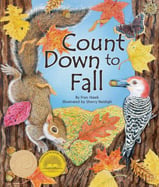Alignment to Standards for DC

| Grade | Number | Standard |
|---|---|---|
| 1 | SC.1.1.1. | Observe, describe, draw, and sort objects as a way of isolating and categorizing some of their properties. |
| 1 | SC.1.2.1. | Recognize and explain that water, rocks, soil, and living organisms are found on the Earths surface. |
| 1 | SC.1.4. | Different types of plants and animals inhabit the Earth. |
| 1 | SC.1.4.2. | there can be differences, such as size or markings, among the individuals within one particular plant or animal group (e.g., maple trees, zebras). Variation is a normal characteristic of many kinds of living things. |
| 1 | SC.1.4.3. | animals eat plants and/or other animals for food. |
| 2 | SC.2.3.1. | Explain how weather patterns occur continually on Earth. |
| 2 | SC.2.6. | Plants and animals have structures that serve different functions in growth, survival, and reproduction. |
| 2 | SC.2.6.1. | visible, external features of plants and animals and describe how these features help them live in different environments. |
| 2 | SC.2.6.2. | some animals and plants change their appearance as the seasons change. |
| 2 | SC.2.7. | Living things depend on one another and their environment for survival. |
| 2 | SC.2.7.1. | Observe and describe how animals may use plants, or even other animals, for shelter and nesting. |
| 2 | SC.2.7.4. | materials in nature, such as grass, twigs, sticks, and leaves, can be recycled and used again, sometimes in different forms, as birds do in making their nests. |
| 2 | SC.2.8. | Many different types of plants and animals inhabit the Earth. |
| 2 | SC.2.8.1. | living things are found almost everywhere in the world in habitats such as the oceans, rivers, rain forests, mountain ranges, arctic tundra, farms, cities, and other environments. Recognize that some habitats are extreme, such a |
| 3 | SC.3.5.1. | living things can be sorted into groups in many ways using various properties, such as how they look, where they live, and how they act, in order to decide which things belong to which group. |
| 3 | SC.3.7.4. | Recognize that food provides energy as well as materials for growth, maintenance, and repair of body parts. |
| 4 | SC.4.7.1. | Explain that organisms interact with one another in various ways, such as providing food, pollination, and seed dispersal. |
| 4 | SC.4.7.3. | Describe how energy derived from the sun is used by green plants to produce chemical energy in the form of sugars (photosynthesis), and this energy is transferred along a food chain from producers (plants) to consumers to decomposers. |
| 4 | SC.4.7.5. | Describe the structures in plants (leaves, roots, flowers, stem, bark, wood) that are responsible for food production, support, water transport, growth, and protection. |
| 5 | SC.5.8. | Many characteristics of an organism are inherited from the parents, but others result from the influence of the environment. |
| 5 | SC.5.8.2. | List some characteristics of plants and animals that are fully inherited (e.g., form of flower, shape of leaves) and others that are affected by the climate or environmental conditions (e.g., browning of leaves from too much sun, language spoken). |
| 5 | SC.5.9. | Adaptations in physical structure or behavior may improve an organismês chance for survival. |
| 5 | SC.5.9.6. | many plants and animals can survive harsh environments because of seasonal behaviors (e.g., in winter, some trees shed leaves, some animals hibernate). |
| 5 | SC.5.9.7. | Recognize that some behaviors are instinctive (turtles burying their eggs) and others learned (wolfês hunting skills). |